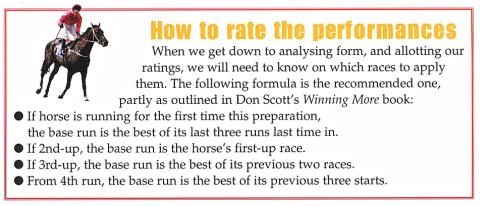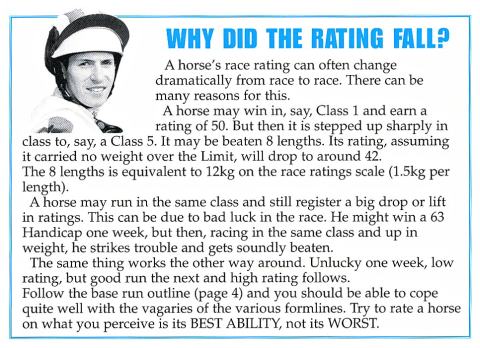The aim of this new series of articles is to provide you with a formula for doing the form. Not such an easy assignment, as we all know. However, with a bit of leeway here and there, I think we can work to a set of rules that will allow us to be pretty darned accurate when we analyse a race.
For starters, always bear in mind that you're going to make mistakes. To err is human, and the racing game is a minefield of human errors. What we have to try to do is NOT to repeat the errors we make.
Years ago, the late Walter Mitchell, a consummate professional, handed out the following advice: 'Punters should remember what they were taught in kindergarten, to learn from their mistakes. If they can do this, then they'll give themselves the chance to win. If they refuse to be guided by past errors, they should give up betting.'
I guess one of the most common mistakes is to allow one factor to sway you towards a certain horse, or to sway you away from it. One factor will rarely allow you to make a considered judgement. Form is all about drawing together the various strands.
When you study a horse's form, you must try to consider all the important factors. By and large, you'll find that the runner with the most factors in its favour is the runner that's going to give you a bold run for your money.
I'll quickly go through the sort of factors I'm going to cover in this series of articles. Consider them, if you will, as a tutorial on form. I'm sure they will help you to get things into order, and to make selections that are soundly based on form principles.

THE RACE: We have to choose which races are suitable for analysis. Not all races are worth investigating. I'll advise which races are suitable and which ones you should try to avoid.
FITNESS: Obviously, a vital ingredient. We'll adopt a formula that allows us to determine fitness according to various gradings, A, B, C and so on. In this way, you can measure one runner against another if all other factors show them to be closely matched.
CLASS: We'll examine the whole 'class' thing. How best to measure one horse's class against another. There is a formula for this; I'm sure it will intrigue you.
ABILITY: A horse may have a lot of factors in its favour, but does it really have the ability to win? We'll look at its overall performances and, using our formula, decide which runners are backable.
FORM: We need to decide which of a horse's races are the ones that are relevant to the current race. The formula for this is contained in the panel below (How To Rate The Performances). It's most important we evaluate a horse using the right formlines.
CONDITIONS: Each day's racing brings its own set of conditions from track to track. These days, conditions change all the time. 'Heavy' at one track may equal only 'slow' at another and so on. We have to find the formula that tells us, as truly as possible, whether a horse can handle the prevailing conditions.
CONNECTIONS: Who trains a horse, and who rides it, and often who owns it, all mean something when it comes to assessment of each horse's claims in a race. Some jockeys mean a good ride is likely but a shorter than required price (due to fanatical following); other jockeys can provide good ride PLUS good price.
WEIGHT: One of the cornerstones of the entire form assessment area. We ignore the impact of weight at our peril. The formula I've devised will enable us to cope with the weight riddle.
These, then, are some of the factors that we'll be investigating in this series of articles. Ican only stress again that each factor is important. The application of each one will help you avoid the mistakes and the 'fallacies' that often surround bad bets.
Never forget the advice, too, that you should hold post-mortems on each race on which you bet. You can learn much from analysing what happened. This applies whether your bet was a winner or not.
If you committed a mistake, you'll realise where you went wrong (hopefully), Maybe you simply made the fundamental error of picking the wrong race on which to bet? Maybe your horse was out of luck? Was it a bad ride? Did the barrier, or the weight impost, mean the difference between winning and losing? Did you ignore a horse that deserved more attention?
These are all questions that can be asked. You'll be doing yourself a favour if you ask them of yourself. Couple this with video analysis, and you have an ideal post-race probe situation. Don't forget to read all you can about a race as well.
Maybe I don't need to remind you to cheek up on reports issued by the stewards. These often contain gems of information which you can tuck away for future reference. Most punters never bother to read these reports, so you can sometimes secure a nice 'edge' on information most others will miss spotting.
Now, let's get down to the business of setting up our form formula. I'll try to set things out as simply as I can. As one who never likes things to be too complicated, I have designed all that follows with speed and simplicity in mind, yet without trimming too many edges. WHICH RACES?
We have to determine the races on which we will operate. There are good races and bad races. A close examination of each race will probably drive you crazy. It's time consuming and inefficient.
The formula I've drawn up requires us to be direct and straightforward in our thinking. We'll use a broad sweep of the brush to eliminate many 'dodgy' races from our list. We simply cannot afford to clutter our betting with too much rubbish.
I've designed the formula to take into account city and provincial/ country racing (TAB meetings, of course). Apply it, and you will know, within a minute or two, which races you need to concentrate on each day.
METROPOLITAN (Weekdays and Saturdays)
- Ignore all races except Open and Restricted Handicaps, Welters, Fillies & Mares, WFA, Set Weights for 2yos and 3yo's.
- Ignore any race with 15 or more runners.
- Ignore any race lower than 1000m.
- If pre-race favourite at evens or lower: IGNORE.
- If race is restricted to apprentice riders: IGNORE. (This will happen only rarely.)
THE RATINGS: These will be from 55 for Restricted 1MW Handicaps to 70 for WFA races. This is a range of some 15kg (approximately 10 lengths). The full list will be published in next month's PPM in the second article in this series.

PROVINCIAL COUNTRY
- Operate only on Class 5, Class 6, Welters, Fillies & Mares, Open Handicaps.
- Ignore any race with 13 or more runners.
- Ignore any race lower than 1000m.
- If pre-race favourite at evens or lower: IGNORE.
- If race is restricted to apprentice riders: IGNORE.
THE RATINGS: These will be from 49 for a Class 5 through to 54 for an Open Handicap, but up to 63 for a major feature handicap (like a Ballarat Cup, Werribee Cup, etc.). The full list will be published in next month's PPM.
Click here to read Part 2.
Click here to read Part 3.
Click here to read Part 4.
Click here to read Part 5.
Click Here to read Part 6.
By Richard Hartley Jnr.
PRACTICAL PUNTING - MAY 2000